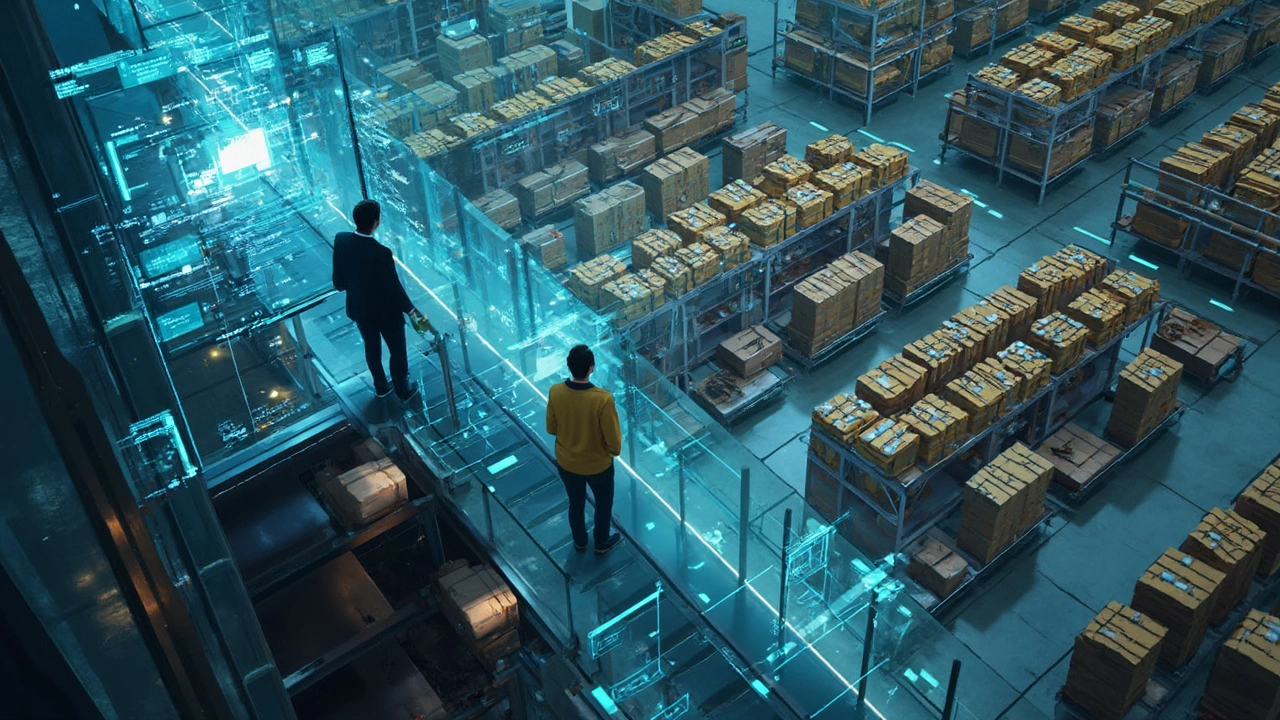Warehouses used to be all about heavy lifting and endless shelves, but today's reality looks way different. Technology has made warehouses almost unrecognizable compared to just a decade ago. Now, robots zip around picking products, software predicts stock before it runs out, and data flows in real-time to tell you exactly where every item sits.
If you’re running a warehouse or thinking about streamlining your operations, ignoring tech is like leaving money on the table. The smartest warehouses out there can double their productivity using modern solutions—think robot arms that never get tired or cloud-based systems that spot inventory hiccups before they become disasters. Even small upgrades, like automated storage systems, can shave hours off a single day’s work and boost order accuracy at the same time.
- Robots and Automation
- AI-Powered Inventory Management
- Smart Storage Systems
- Real-Time Tracking and IoT
- Sustainable Technologies
Robots and Automation
Robots have pretty much taken warehouse work to another level. They’re not science fiction anymore; robots are everywhere in modern warehousing. Some big players—like Amazon—now use over 750,000 mobile robots to speed up picking and packing. These rolling bots cruise around aisles, grabbing products faster and safer than people ever could. The cool part? They don't need lunch breaks or sick days, so your operation never skips a beat.
Automated Guided Vehicles (AGVs) and Autonomous Mobile Robots (AMRs) are two types making a big impact. AGVs follow tracks or wires on the floor, while AMRs use smart sensors to go anywhere in the warehouse without bumping into stuff. If your shelves are high (like those tall warehouse racks that look impossible to reach), robotic arms now do the heavy lifting. They grab, stack, and even sort items without any drama.
- Warehouse automation can cut walking time for staff by up to 60%.
- Robots rarely make mistakes—one study found order accuracy reached 99.9% in fully automated setups.
- Picking robots work especially well with tedious and repetitive tasks, like moving small boxes or cartons.
If you’re worried about robots replacing workers, here’s a tip: most places use robots to handle dull or dangerous jobs, so staff can switch over to higher-skill tasks that need a human touch. Training your team to work side-by-side with automation keeps morale up and lets you scale faster.
Here’s a quick look at why warehouses are jumping on the automation train:
| Benefit | Typical Improvement |
|---|---|
| Speed | Order picking 2x faster |
| Accuracy | Up to 99.9% in some cases |
| Labor cost | 20-40% savings |
| Safety | Fewer workplace injuries |
Robots and automation aren’t just for the biggest warehouses. Smaller operations can lease these systems or try “robot-as-a-service” models, so there’s no need for a huge up-front investment. The bottom line: if you want your warehouse to stay competitive, it’s tough to ignore the power of automation.
AI-Powered Inventory Management
If you want to keep up in the modern warehousing game, AI isn’t optional—it’s the secret weapon. Instead of guessing how much stock you’ll need, AI tools dig through your sales data, supplier lead times, and even seasonal trends to predict inventory levels way before you see a shortage or overflow.
Big names like Amazon and Walmart use AI systems that analyze millions of transactions in real-time. Smaller businesses can use cloud-based tools like Locus or inVia, which also power up inventory management for the rest of us. These systems don’t just count what’s on the shelves; they can automatically reorder products when the level drops, helping you avoid the classic out-of-stock panic or a warehouse packed with stuff that doesn’t move.
With AI calling the shots, warehouses can:
- Reduce overstock and stockouts by up to 30%, just by being smarter about what they order.
- Track product flow and spot slow movers, so you can make decisions that actually boost profits.
- Get alerts the second a hiccup hits your supply chain—no more surprises when a crucial item vanishes.
Here’s a quick look at some real differences AI brings to inventory management:
| Old-School Methods | AI-Powered Systems |
|---|---|
| Manual counting and spreadsheets | Automatic tracking with sensors and cloud analytics |
| Reactive reordering when goods run out | Predictive replenishment before stock runs low |
| Hard to spot errors or trends | Instant alerts and smart trend spotting |
One pro tip: Start small by automating just a section of your warehouse first. Once you see the gains—fewer mistakes, less wasted time—you’ll wonder why you didn’t make the switch sooner. With AI-powered inventory management, both accuracy and speed get a serious upgrade.

Smart Storage Systems
Gone are the days when workers had to hunt through rows of shelves hoping to find the right product. Smart storage systems use a mix of automated shelves, lifts, and digital controls to keep things organized and easy to find. These systems aren’t just flashy—they solve real headaches, like wasted space and mix-ups in shipments.
The cool part? Some modern warehouses use Automated Storage and Retrieval Systems (AS/RS), which are basically warehouse “vending machines” run by computers. These setups can store and pick items way faster than a person could. They even work around the clock, so late orders don’t pile up overnight. Fun fact: An AS/RS setup can cut picking errors by 70% and bump up storage density by at least 40%. That’s a huge change for crowded spaces.
Here’s how these systems make warehouses smarter:
- Vertical lift modules: These tall lift towers save floor space and pull trays with products directly to operators at the push of a button.
- Carousel systems: Rotating shelves bring items right to the user, which means fewer steps for staff and less chance for mistakes.
- Dynamic slotting: Software tracks which items move fastest and stores them in easy-to-reach spots, cutting down picker travel time.
- Barcode and RFID integration: Every item’s location is tracked, so you always know what’s in stock and where it’s sitting.
Check out how different storage systems stack up:
| System Type | Space Saved | Error Reduction |
|---|---|---|
| Manual Shelving | 0% | Baseline |
| Vertical Lift Module | Up to 85% | 60% |
| Carousel System | Up to 65% | 50% |
| AS/RS | 40%+ | 70% |
For smaller operations, modular shelving with built-in scanning can still make a big impact without a massive investment. The bottom line? Smart storage systems make the most of every inch of space, slash mistakes, and keep your inventory moving fast and accurately.
Real-Time Tracking and IoT
Let’s talk about how real-time tracking and the Internet of Things (IoT) are making warehouses a lot smarter—sometimes even smarter than the people running them. Smart sensors and connected devices let you follow each item in the building without guesswork or manual checks. Forget clipboards and scribbled notes; now you can use RFID tags, GPS trackers, and IoT sensors to get live updates on everything from pallets to forklifts. No more running around hunting for missing goods or double-checking aisles.
With these smart warehouse solutions, you see the real-time location of every product on the floor. If something moves, your dashboard updates automatically. This makes a massive difference for accuracy and cuts down on lost or misplaced inventory. It’s not just for big players either—warehouse management systems (WMS) with built-in IoT support are affordable even for smaller businesses these days.
- RFID tags beat out traditional barcodes because workers don’t have to scan each item by hand. Products are tracked just by passing through gates or checkpoints.
- IoT sensors keep tabs on environmental factors like temperature and humidity, which is critical for food, medicine, or anything sensitive.
- With GPS-enabled trackers, you’re always updated on fleet and shipment movement—no more waiting for drivers to call in with their locations.
This tech isn’t just impressive, it saves real money. A 2024 report by MHI found that companies saw an average of 15% reduction in inventory errors after switching to IoT-powered real-time tracking. Plus, customers get faster, more reliable deliveries because the entire supply chain reacts faster to hiccups.
If you want to avoid headaches, lost items, or slow shipments, adding real-time tracking tools and IoT to your warehouse is a solid move. It takes the guesswork out of inventory management and puts you in the driver’s seat.

Sustainable Technologies
Green tech isn’t a buzzword in warehouses anymore—it’s just smart business. Besides helping the environment, these upgrades can cut costs and make day-to-day operations smoother. Modern warehousing is leaning hard into energy-saving systems and smarter tech to shrink waste and lower utility bills.
Let’s talk lighting. LED systems are popping up everywhere because they last way longer than traditional bulbs and use about 75% less energy. Add motion sensors, and now you’re only lighting spaces when someone or something is actually there. These small changes can save thousands in a typical mid-sized building every year.
Solar panels are another hot trend. Roof space that used to sit unused can now generate serious power. Warehouses in sunny states like California can meet more than half their own energy needs this way. There’s also a clear shift toward electric forklifts and delivery vehicles. They’re quieter, need less maintenance, and you can plug them right into your renewable power setup—no more worrying about diesel fumes inside closed spaces.
Waste is getting tackled with smarter inventory management systems, too. By using AI and tracking software, companies can stop over-ordering or letting products expire, which means less stuff heading to the landfill. Some big retailers credit their new systems with slashing stock waste by as much as 40%.
| Sustainable Practice | Potential Savings | Environmental Benefit |
|---|---|---|
| LED Lighting | Up to 75% lower energy use | Less CO2 from electricity |
| Solar Roof Panels | Up to 60% lower utility bills | Reduces fossil fuel dependence |
| AI Inventory Management | 40% less excess stock | Reduces landfill waste |
If you’re thinking about these upgrades, check for local rebates or tax breaks. These incentives can often cover a chunk of your upfront costs, making it a no-brainer to start building a more sustainable warehouse.





